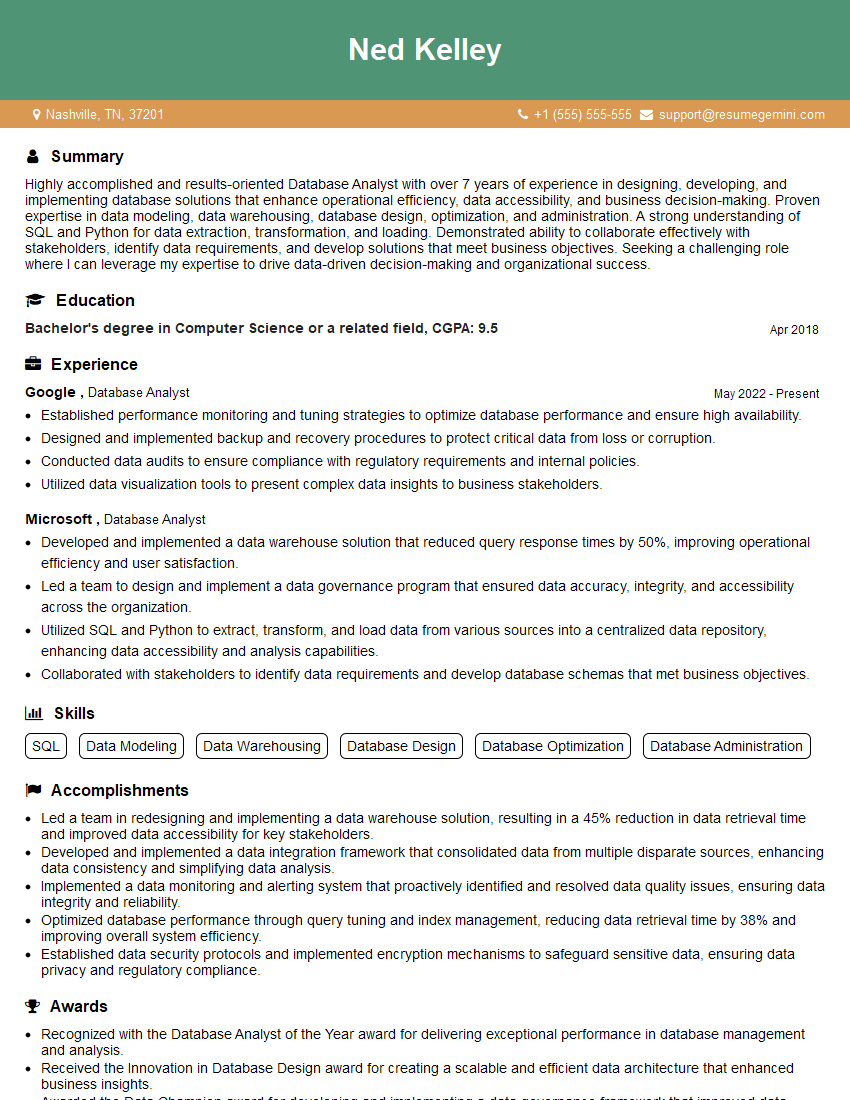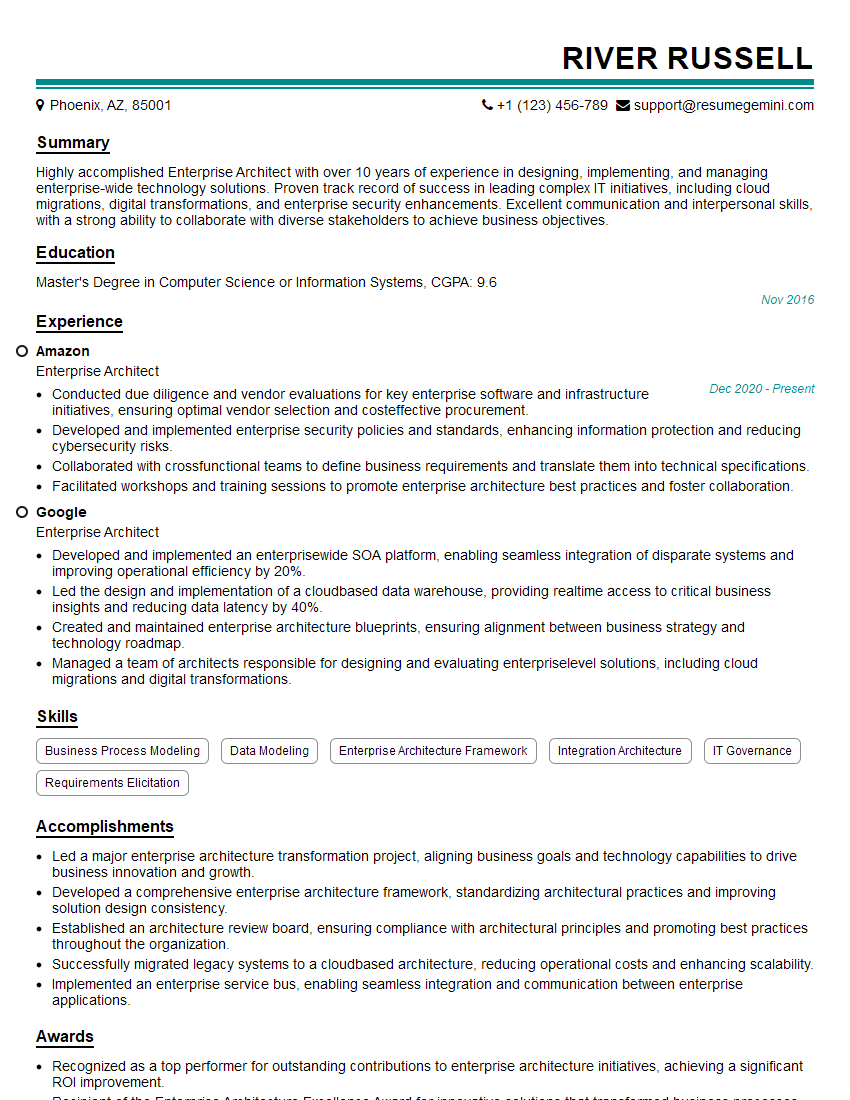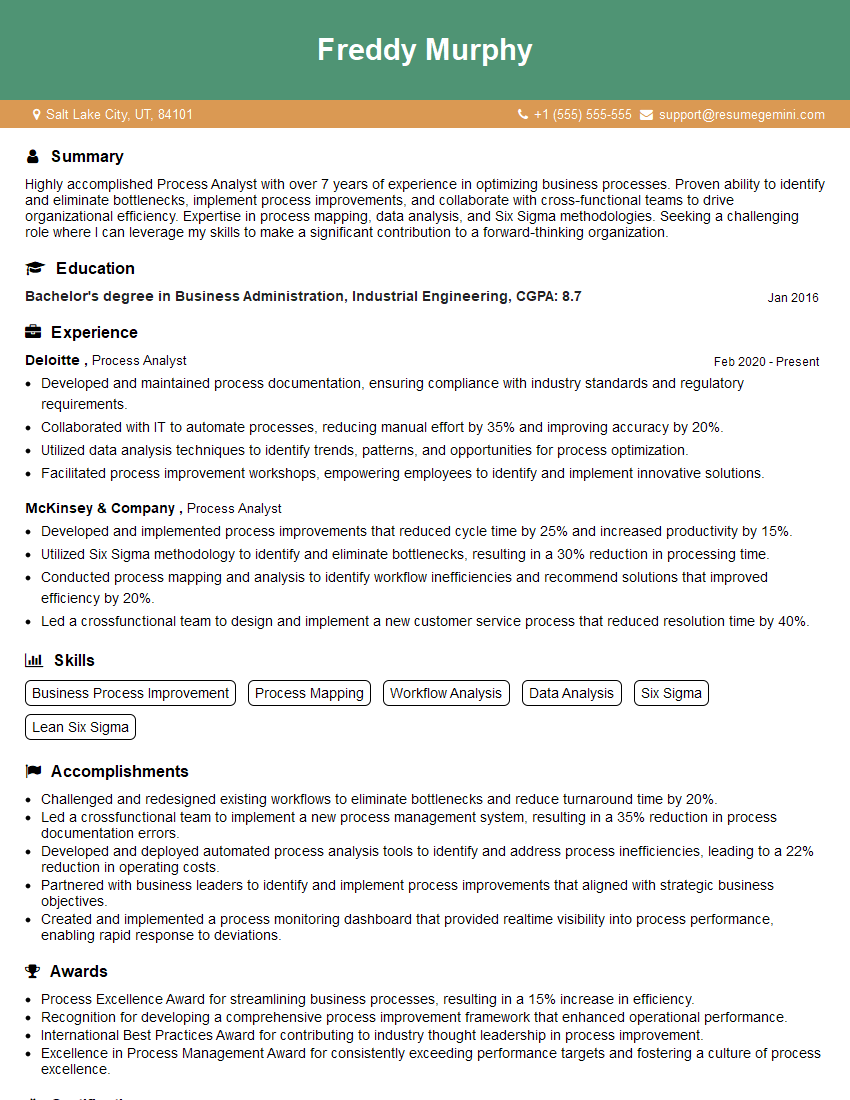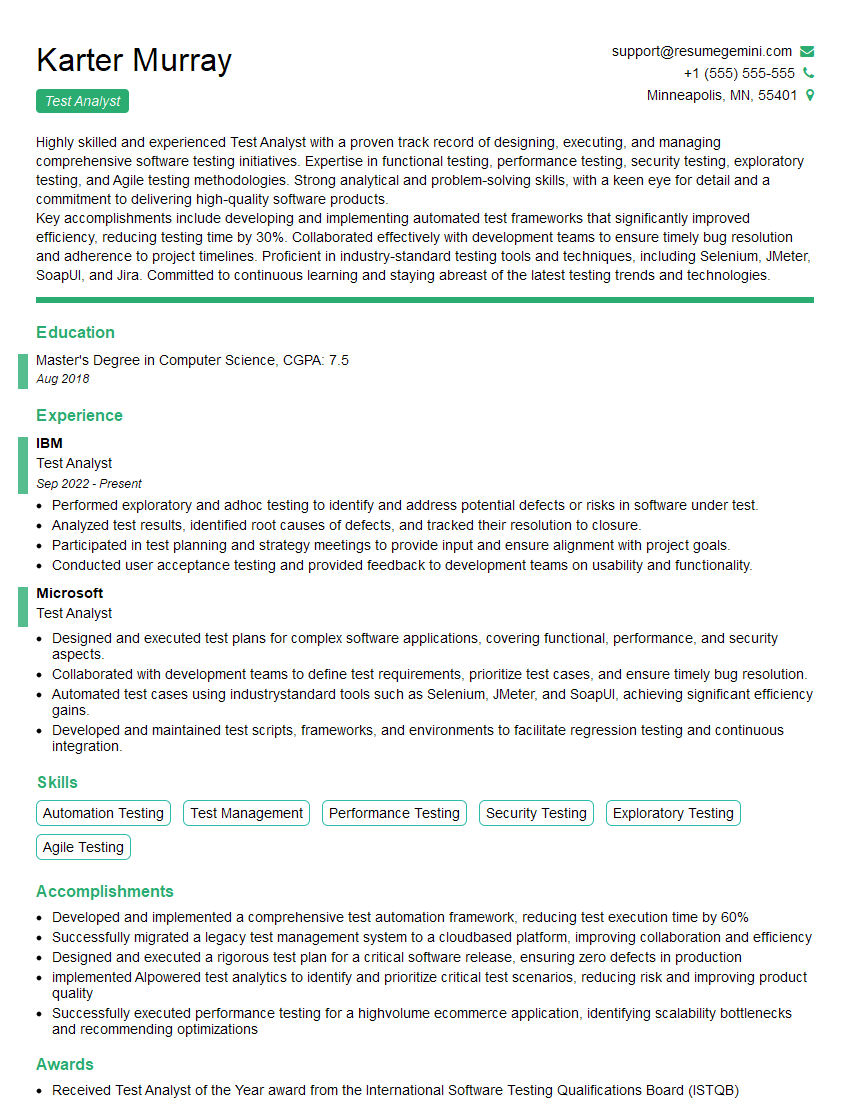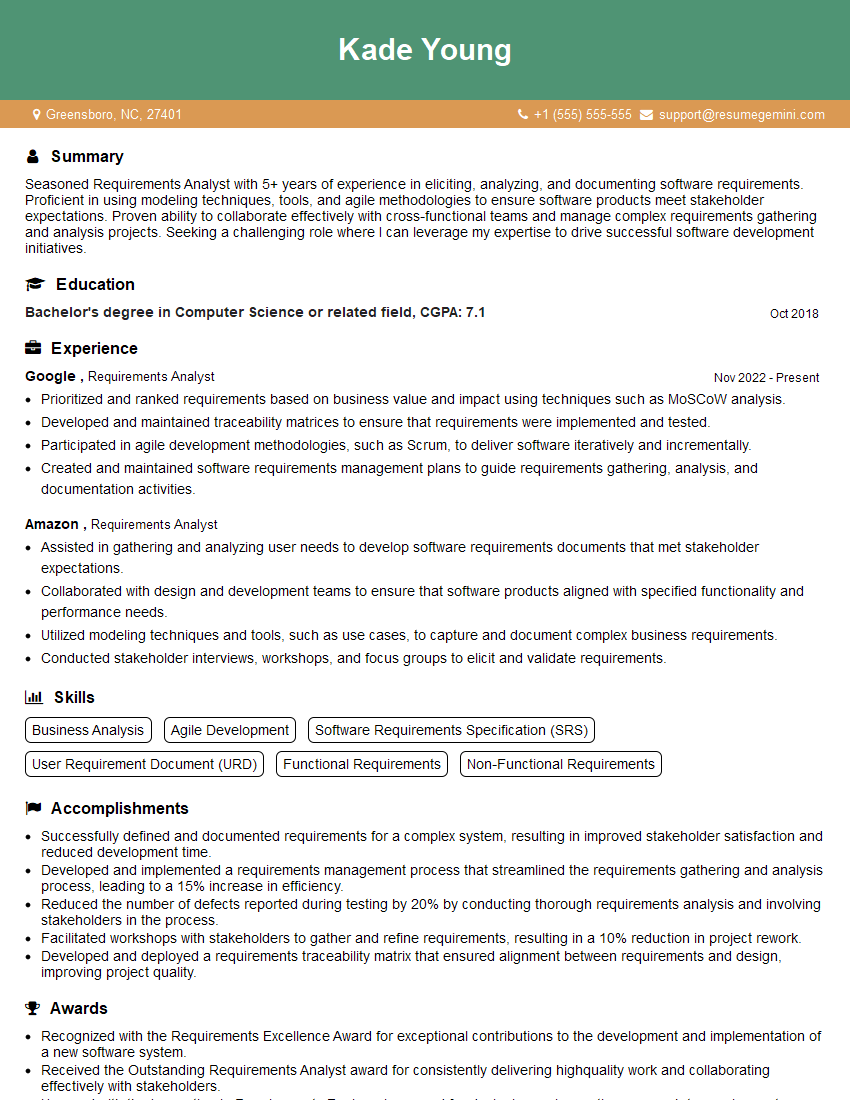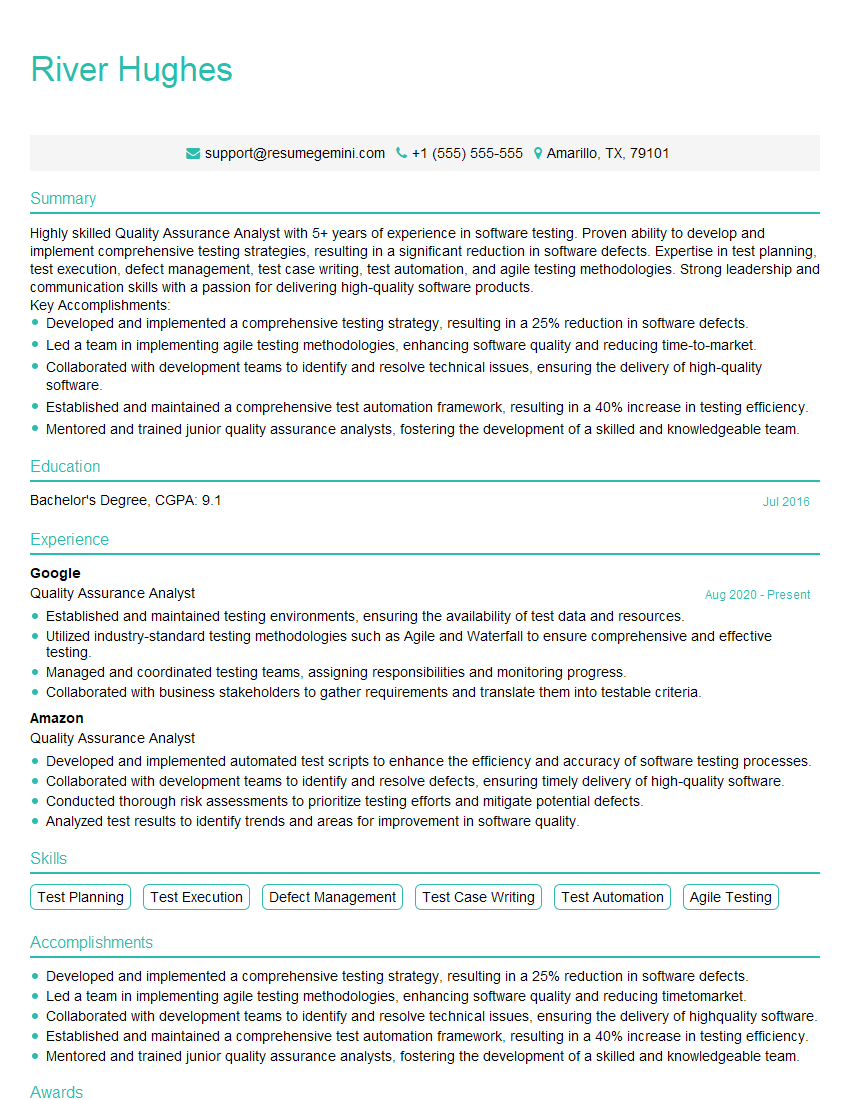The thought of an interview can be nerve-wracking, but the right preparation can make all the difference. Explore this comprehensive guide to Requirement Analysis and Traceability Matrix interview questions and gain the confidence you need to showcase your abilities and secure the role.
Questions Asked in Requirement Analysis and Traceability Matrix Interview
Q 1. Explain the importance of requirement analysis in software development.
Requirement analysis is the foundation of successful software development. It’s the process of understanding what a system needs to do before you start building it. Think of it as creating a detailed blueprint for a house before you start laying the bricks – without it, you risk building something that doesn’t meet the needs of the inhabitants (your users!). A thorough requirement analysis ensures the final product aligns with stakeholder expectations, reduces costly rework later in the development cycle, and prevents project failure.
Imagine you’re building an e-commerce website. Requirement analysis would involve defining aspects like user registration processes, product catalog management, shopping cart functionality, payment gateways, and order tracking. Without a clear understanding of these requirements, you might end up with a website that’s difficult to use, lacks key features, or has security vulnerabilities.
Q 2. Describe different techniques used for requirements elicitation.
Several techniques are employed for requirements elicitation, the process of gathering information about what the system should do. These techniques can be broadly classified into:
- Interviews: Direct conversations with stakeholders to understand their needs and expectations. This allows for clarification and in-depth understanding.
- Surveys and Questionnaires: Efficient for gathering information from a large group of stakeholders, offering a standardized approach. However, they lack the depth of interviews.
- Workshops and Focus Groups: Facilitated sessions involving key stakeholders to brainstorm and collaboratively define requirements. These encourage participation and shared understanding.
- Prototyping: Creating early versions of the system to gather feedback and refine requirements iteratively. This allows for tangible demonstration and user interaction.
- Document Analysis: Reviewing existing documents such as business plans, user manuals, and process flows to identify relevant requirements. This provides a historical perspective and context.
- Observation: Directly observing users interacting with existing systems to understand their workflows and pain points. This offers insights into real-world user behavior.
The best approach often involves a combination of these techniques, tailored to the specific project and context.
Q 3. What are the key characteristics of a good requirement?
A good requirement possesses several key characteristics:
- Clear and Unambiguous: Easy to understand and interpret, leaving no room for multiple interpretations. For example, instead of ‘the system should be fast,’ a better requirement would be ‘the system should load a product page in under 2 seconds’.
- Feasible: Technically and practically achievable within the project constraints (time, budget, technology).
- Testable: It should be possible to verify whether the requirement has been met through testing. A testable requirement might be ‘The system shall generate an order confirmation email within 5 minutes of order placement’.
- Complete and Consistent: All necessary details are provided, and there are no contradictions with other requirements.
- Prioritized: Requirements are ranked based on importance and urgency to guide development efforts. This allows focusing on essential features first.
- Traceable: The requirement can be linked to its origin (e.g., a user story) and to the design, implementation, and test artifacts.
Q 4. How do you handle conflicting requirements?
Conflicting requirements are common and require careful negotiation and prioritization. The process involves:
- Identify the conflict: Clearly define the conflicting requirements and the nature of the conflict.
- Analyze the impact: Assess the consequences of each requirement and the potential impact on the system.
- Negotiate and prioritize: Involve stakeholders to discuss the conflict and reach a consensus. This may involve trade-offs, compromises, or prioritization based on business value.
- Document the resolution: Clearly record the agreed-upon resolution to avoid future misunderstandings.
- Re-evaluate: Monitor the impact of the chosen resolution and make adjustments if necessary.
For instance, a conflict might arise between a requirement for high performance and a requirement for extensive functionality. Resolving this might involve prioritizing performance for critical features while deferring less critical functionality to a later release.
Q 5. Explain the purpose of a traceability matrix.
A traceability matrix is a document that maps requirements to other project artifacts such as design specifications, test cases, and code modules. It ensures that all requirements are addressed and facilitates impact analysis when changes occur. Think of it as a ‘map’ showing the relationships between different aspects of the project. It’s crucial for verification and validation, demonstrating that the system built actually meets the specified requirements.
In a real-world scenario, a traceability matrix would be invaluable during audits or regulatory compliance checks, providing a clear audit trail of requirements and their implementation.
Q 6. What are the different types of traceability links?
Traceability links can be categorized as follows:
- Requirement-to-Design: Links a requirement to the design elements that fulfill it.
- Requirement-to-Code: Connects a requirement to the code modules that implement it.
- Requirement-to-Test: Shows which test cases verify a specific requirement.
- Design-to-Code: Links design components to the corresponding code.
- Design-to-Test: Maps design elements to the test cases that validate them.
- Code-to-Test: Indicates which code is covered by which tests.
These links create a network showing how different aspects of the system are interconnected, providing a complete view of the development process and facilitating impact analysis when changes are introduced.
Q 7. How do you create and maintain a traceability matrix?
Creating and maintaining a traceability matrix involves several steps:
- Identify requirements: Clearly define and document all requirements.
- Identify other artifacts: Determine the design specifications, code modules, and test cases.
- Establish links: Create the matrix by linking requirements to the corresponding artifacts. This can be done manually or using specialized traceability tools.
- Update regularly: Maintain the matrix throughout the development lifecycle, updating it whenever changes are made to requirements or other artifacts. This ensures the matrix remains accurate and reflects the current state of the project.
- Use a tool: Consider using specialized software for traceability matrix management. This simplifies the process, particularly for large projects.
Regular review and updates are crucial for the accuracy and usefulness of the traceability matrix. Neglecting this can lead to inconsistencies and difficulties in tracking progress and resolving issues. Tools can significantly improve efficiency, offering features such as automated linking and reporting.
Q 8. How do you ensure requirements are complete, consistent, and unambiguous?
Ensuring requirements are complete, consistent, and unambiguous is crucial for successful software development. Think of it like building a house – if the blueprints (requirements) are incomplete, inconsistent, or unclear, the final product will be flawed. I achieve this through a multi-pronged approach:
- Requirement Elicitation Techniques: I utilize various techniques like interviews, workshops, surveys, and prototyping to gather information from stakeholders. This ensures we capture all aspects of their needs.
- Formal Review and Inspections: We conduct formal reviews with stakeholders to validate the requirements. This involves walkthroughs and inspections by different team members to check for inconsistencies and ambiguities. A checklist is typically used to ensure all aspects are considered.
- Use Case Modeling: Visualizing requirements through use case diagrams helps clarify the interactions between the system and users, revealing potential gaps or inconsistencies. This offers a clear, visual representation for better understanding.
- Prototyping: Building prototypes, even simple ones, allows stakeholders to interact with a representation of the system, identifying early on any misunderstandings or missing features. This is particularly helpful for complex or novel requirements.
- Requirement Prioritization and Scope Management: Clearly defining and prioritizing requirements helps manage scope and prevents unnecessary complexity, thereby enhancing clarity and consistency.
For example, in a recent project developing an e-commerce platform, we used user story mapping to capture all aspects of the user journey. This led to the identification of an overlooked requirement related to secure payment processing, which would have resulted in significant issues later on.
Q 9. Describe your experience with requirements management tools.
I have extensive experience with various requirements management tools, including Jira, Confluence, and DOORS. Each tool offers unique features, but my selection depends on project needs and team preferences.
Jira, for instance, excels at managing tasks and tracking progress, particularly useful for agile projects. Confluence is excellent for documentation and collaboration, facilitating easy sharing and review of requirements. DOORS is a powerful tool for larger, more complex projects requiring stringent traceability and configuration management.
My experience encompasses not only using these tools for requirement capture, but also for creating traceability matrices, managing change requests, and generating reports to track progress and ensure compliance with requirements.
I’m also proficient in using version control systems like Git, ensuring that changes to requirements are tracked and managed effectively. This is crucial for maintaining a clear audit trail and preventing confusion resulting from multiple versions of documents.
Q 10. How do you prioritize requirements?
Requirement prioritization is a critical aspect of successful project management. It ensures that the most valuable features are developed first, maximizing return on investment (ROI) and meeting critical business needs.
I typically use a combination of techniques, including:
- MoSCoW Method: Categorizing requirements into Must have, Should have, Could have, and Won’t have allows for a clear understanding of priorities.
- Value vs. Effort Matrix: Plotting requirements based on their business value and development effort helps visualize trade-offs and identify high-value, low-effort items.
- Stakeholder Collaboration: Involving stakeholders in the prioritization process ensures buy-in and alignment on the project’s direction. This ensures that the team focuses on the most important features from a business perspective.
- Risk Assessment: Identifying potential risks associated with each requirement helps prioritize those that could have the greatest impact if not addressed promptly.
For example, in a project for a healthcare provider, we used the MoSCoW method. Prioritizing ‘must-have’ features like patient data security ensured the system met essential regulatory requirements before implementing ‘should-have’ features such as advanced analytics.
Q 11. How do you manage changes to requirements?
Managing changes to requirements is an inevitable aspect of software development. It’s important to have a structured approach to ensure changes are controlled, documented, and communicated effectively.
My approach includes:
- Change Request Process: Establishing a formal process for submitting, reviewing, and approving change requests. This usually includes a form for documenting the proposed change, its impact, and rationale.
- Impact Analysis: Carefully assessing the impact of any change on the project schedule, budget, and scope. This prevents unforeseen complications.
- Version Control: Using a version control system to track changes to requirements and their associated documentation. This allows easy tracking of the evolution of requirements.
- Communication and Stakeholder Management: Keeping all stakeholders informed of any changes and their implications. This ensures transparency and prevents misunderstandings.
- Traceability Matrix Updates: Updating the traceability matrix to reflect the impact of the change on design, code, and test cases.
For instance, in a project involving a mobile app, we used a change request system that triggered automated notifications to relevant stakeholders. This ensured quick response times and minimized delays caused by unmet requirements.
Q 12. Explain the difference between functional and non-functional requirements.
Functional and non-functional requirements describe different aspects of a system. Think of it like this: functional requirements define *what* the system does, while non-functional requirements define *how* it does it.
- Functional Requirements: These describe the specific functions or features the system must perform. Examples include: ‘The system shall allow users to create an account,’ ‘The system shall calculate the total price of items in the shopping cart,’ or ‘The system shall send email notifications to users.’ These are often expressed as user stories or use cases.
- Non-Functional Requirements: These describe qualities and constraints related to the system’s performance, security, usability, and maintainability. Examples include: ‘The system shall respond to user requests within 2 seconds,’ ‘The system shall protect user data according to HIPAA regulations,’ or ‘The system shall be easy to use for users with limited technical skills.’
It’s crucial to address both types of requirements effectively, as neglecting non-functional requirements can lead to a system that functions correctly but is unusable, insecure, or unreliable.
Q 13. How do you validate and verify requirements?
Validation and verification are distinct but complementary processes that ensure the requirements are correct and that the system meets those requirements. Validation answers the question: ‘Are we building the right product?’, while verification answers ‘Are we building the product right?’
- Requirements Validation: This involves ensuring that the requirements accurately reflect the needs of stakeholders. Techniques include prototyping, reviews, walkthroughs, and surveys to confirm stakeholder satisfaction with the requirements.
- Requirements Verification: This involves confirming that the system meets the defined requirements. Techniques include testing, inspections, and analysis of the system to ensure it behaves as expected according to the specifications.
A key element in both processes is using a Traceability Matrix, which links requirements to design documents, code, and test cases, providing a clear audit trail and facilitating both validation and verification. If a requirement changes, the matrix helps identify all affected components, simplifying the change management process.
Q 14. What are the common challenges in requirement analysis?
Requirement analysis faces various challenges. Some common ones include:
- Incomplete or Conflicting Requirements: Stakeholders may have conflicting priorities or fail to articulate their needs completely. This often stems from poor communication or a lack of clear understanding of the system’s purpose.
- Changing Requirements: Requirements may change due to evolving business needs or technological advancements. This requires flexible and adaptive management strategies.
- Unrealistic Expectations: Stakeholders may have unrealistic expectations regarding functionality, performance, or deadlines. Effective communication and realistic planning can help mitigate this.
- Difficulty in Prioritization: Determining which requirements are most critical can be difficult, requiring careful analysis and stakeholder involvement.
- Lack of Stakeholder Involvement: Inadequate involvement of stakeholders leads to requirements that do not truly reflect their needs.
- Poor Communication: Miscommunication between stakeholders and the development team can result in misunderstandings and errors.
Addressing these challenges requires strong communication, collaboration, and a structured approach to requirement elicitation, documentation, and management.
Q 15. How do you handle ambiguous or incomplete requirements?
Ambiguous or incomplete requirements are a common challenge in software development. They can lead to misunderstandings, delays, and ultimately, a product that doesn’t meet the needs of its users. My approach involves a multi-pronged strategy focusing on clarification, collaboration, and documentation.
- Elicit Clarification: I directly engage with stakeholders, using techniques like probing questions and facilitated workshops to understand the underlying intent behind the ambiguous requirements. For example, instead of accepting a requirement like “the system should be fast,” I would ask questions like “What is the acceptable response time?” or “What are the performance benchmarks we should aim for?”
- Collaborate and Iterate: I encourage collaborative brainstorming sessions involving developers, testers, and stakeholders. This collaborative approach helps to identify missing pieces and refine the understanding of the requirement. We iterate on the requirements, creating prototypes or mockups to validate our understanding and ensure alignment.
- Document Thoroughly: Once clarified, requirements are meticulously documented, using unambiguous language and precise definitions. We utilize tools such as requirement management systems to ensure version control and traceability. Any assumptions or decisions made during the clarification process are also explicitly documented.
For example, if a requirement states, “The user interface should be intuitive,” I’d work with stakeholders to define concrete, measurable criteria, such as “Users should be able to complete the core task within three clicks, with an error rate below 5%,” transforming a subjective assessment into an objective, testable measure.
Career Expert Tips:
- Ace those interviews! Prepare effectively by reviewing the Top 50 Most Common Interview Questions on ResumeGemini.
- Navigate your job search with confidence! Explore a wide range of Career Tips on ResumeGemini. Learn about common challenges and recommendations to overcome them.
- Craft the perfect resume! Master the Art of Resume Writing with ResumeGemini’s guide. Showcase your unique qualifications and achievements effectively.
- Don’t miss out on holiday savings! Build your dream resume with ResumeGemini’s ATS optimized templates.
Q 16. Describe your experience with different requirement analysis models (e.g., Waterfall, Agile).
My experience spans both Waterfall and Agile methodologies. Each has its unique approach to requirement analysis.
- Waterfall: In Waterfall, requirements are meticulously documented upfront in a comprehensive Requirements Specification Document (RSD). This document undergoes rigorous review and approval before development begins. The emphasis is on complete upfront analysis to minimize changes during the development lifecycle. This approach is suitable for projects with stable, well-understood requirements.
- Agile: Agile embraces iterative development, with requirements evolving throughout the project lifecycle. User stories are commonly used to capture requirements, allowing for flexibility and adaptation to changing needs. Continuous feedback and collaboration with stakeholders are vital in refining requirements iteratively during sprints. Agile is best suited for projects with dynamic or uncertain requirements.
I’ve successfully employed both approaches, adapting my techniques to the specific project context and the client’s preferences. My experience allows me to seamlessly transition between these methodologies, choosing the most appropriate strategy based on project dynamics and stakeholder expectations.
Q 17. Explain the relationship between requirements and testing.
Requirements and testing are intrinsically linked; testing is directly driven by requirements. Requirements define what the software should do (functional requirements) and how it should perform (non-functional requirements). Testing verifies that the software meets those defined requirements.
- Test Cases Derivation: Each requirement serves as a basis for creating test cases. These test cases aim to demonstrate that the software fulfills each requirement successfully.
- Defect Tracking: When testing reveals defects (bugs), the traceability matrix helps to identify the originating requirement. This allows developers to quickly understand the root cause of the defect and fix it efficiently.
- Test Coverage: Requirement traceability ensures complete test coverage, reducing the risk of overlooking crucial functionalities or performance aspects.
For instance, if a requirement states, “The system shall allow users to log in using their email address and password,” test cases would be designed to verify successful login with valid credentials, handle invalid credentials, and manage various error conditions. Any failure in these tests highlights a defect directly traceable to the original requirement.
Q 18. How do you use a traceability matrix to track defects?
A traceability matrix is invaluable for tracking defects. It establishes a direct link between requirements, test cases, and defects. When a defect is discovered during testing, the traceability matrix is consulted to identify the corresponding requirement and test case.
- Defect Identification: The matrix immediately shows which requirement is not working as expected.
- Root Cause Analysis: This helps pinpoint the source of the problem, facilitating faster debugging and resolution.
- Impact Assessment: It helps determine the impact of the defect on other parts of the system.
For example, if a test case for “User login” fails, the traceability matrix would indicate the related requirement and allow the team to quickly focus on fixing the issue within the login functionality.
Q 19. How do you ensure traceability throughout the software development lifecycle?
Maintaining traceability throughout the Software Development Life Cycle (SDLC) is crucial for effective project management and quality assurance. This requires a systematic approach beginning with requirement capture and continuing through development, testing, and deployment.
- Unique Identifiers: Assigning unique identifiers to each requirement, test case, and defect facilitates easy tracking and linking.
- Traceability Matrix: The use of a traceability matrix, regularly updated, is essential for maintaining clear links between all these artifacts. Tools like spreadsheets or dedicated requirement management systems can be used.
- Version Control: Employing version control systems for all documents ensures that changes are tracked and that the team always has access to the most up-to-date information.
- Regular Reviews: Conducting regular reviews of the traceability matrix helps to identify gaps and ensure that all requirements are adequately covered by tests.
Using a requirement management tool allows for automated traceability, reducing manual effort and improving accuracy. Consistent use of identifiers and regular updates maintain the integrity of the traceability links throughout the entire SDLC.
Q 20. What metrics do you use to measure the effectiveness of requirement analysis?
Measuring the effectiveness of requirement analysis is crucial to ensure project success. Several metrics can be utilized:
- Requirements Completeness: The percentage of requirements that are fully defined and understood.
- Requirement Stability: The rate of change in requirements over time. High instability indicates potential issues with initial analysis.
- Defect Density related to Requirements: The number of defects directly traceable to poorly defined requirements.
- Requirement Traceability Coverage: The percentage of requirements covered by test cases.
- Stakeholder Satisfaction: Feedback from stakeholders on the clarity and completeness of the requirements.
By monitoring these metrics, we can identify areas for improvement in the requirement analysis process, leading to more robust and efficient software development.
Q 21. Describe a situation where you had to deal with a difficult stakeholder regarding requirements.
In a previous project, a key stakeholder insisted on a feature that was technically challenging and would significantly increase development time and cost. Their reasoning was based on a perceived market advantage, while our analysis showed it to be of limited value to the majority of users.
- Data-Driven Discussion: I presented data showing the low projected return on investment (ROI) for this feature compared to other functionalities. I also demonstrated alternative approaches that would achieve similar user benefit with less development effort.
- Collaborative Problem Solving: Instead of direct confrontation, I facilitated a workshop to collaboratively explore the different options, presenting the pros and cons of each, including development costs, timelines, and potential user impact.
- Prioritization and Negotiation: We worked together to prioritize features based on business value and technical feasibility. The stakeholder, having a clearer understanding of the trade-offs involved, agreed to a revised approach that delivered core functionalities first, with the less critical feature considered for future releases.
This experience highlighted the importance of clear communication, data-driven decision-making, and collaborative problem-solving in managing difficult stakeholder expectations. Ultimately, we achieved a successful project outcome that satisfied both technical constraints and business objectives.
Q 22. How do you communicate technical requirements to non-technical stakeholders?
Communicating technical requirements to non-technical stakeholders requires a shift in perspective. Instead of using jargon and technical terms, I focus on translating those concepts into plain language, using analogies and visuals to aid understanding. For example, instead of saying “The database needs to implement a sharded architecture for scalability,” I might say, “Imagine a library with multiple branches instead of one giant room. This makes finding books (data) faster and easier, even with millions of books (data points).”
I also utilize visual aids like diagrams, flowcharts, and mockups to demonstrate the functionality and impact of the requirements. I often employ storytelling techniques, framing requirements within the context of the overall business objective and the user experience. Finally, I actively encourage questions and feedback throughout the communication process, ensuring a shared understanding before moving forward. This iterative approach allows for clarification and prevents misinterpretations.
Q 23. How do you ensure that requirements are aligned with business goals?
Aligning requirements with business goals is paramount. I begin by thoroughly understanding the overarching business objectives through discussions with stakeholders at all levels—from executives to end-users. This involves clarifying the “why” behind the project, its strategic importance, and the desired outcomes. I then create a requirements traceability matrix (RTM) which explicitly links each requirement to a specific business goal. This ensures that every requirement contributes directly to the project’s success. For example, a requirement to “reduce customer support calls by 15%” directly contributes to the business goal of “improving customer satisfaction and reducing operational costs.”
During requirement elicitation and analysis, I continuously refer back to the business objectives, ensuring all proposed functionalities and features contribute to those goals. Regular reviews and discussions with stakeholders help maintain this alignment throughout the project lifecycle, accommodating changes and ensuring we remain focused on the strategic target.
Q 24. What techniques do you use to identify and mitigate risks associated with requirements?
Identifying and mitigating risks associated with requirements is a proactive process. I employ several techniques, starting with risk identification workshops with stakeholders. Brainstorming sessions help uncover potential issues, such as unclear requirements, conflicting priorities, technological limitations, or dependencies on external factors. We then analyze these risks using a risk assessment matrix, considering the likelihood and impact of each risk.
Mitigation strategies are then developed for each identified risk. This might involve adding buffer time to the schedule, allocating contingency resources, or implementing a robust change management process. For example, if a requirement depends on an external API, we’d investigate its reliability, potential downtime, and have alternative solutions in place. Regular monitoring and review of risks throughout the project, and updating the risk register, are crucial to staying ahead of potential problems.
Q 25. Describe your experience with using a requirements management tool.
I have extensive experience using Jira and Confluence for requirements management. Jira’s features allow for structured requirement capture, detailed descriptions, attachments, and linking to test cases and other artifacts. Confluence helps maintain a centralized repository for all requirement documents, specifications, and meeting minutes. The integration between the two tools enables seamless traceability, allowing us to trace requirements through design, development, testing, and deployment. This traceability is crucial for verifying that all requirements are addressed and validated.
I’ve also used tools like DOORS (Dynamic Object-Oriented Requirements System) for more complex projects demanding robust change management and version control. The choice of tool depends on the project’s size, complexity, and the organization’s existing infrastructure. The key is to leverage the tool’s capabilities for effective collaboration, version control, and traceability.
Q 26. How do you handle requirements that are constantly changing?
Handling constantly changing requirements is a challenge, but a manageable one with a structured approach. First, we need a formal change management process. All changes should be documented, reviewed, and approved by stakeholders. This avoids ad-hoc modifications that can destabilize the project. The impact of each change on the project scope, schedule, and budget should be carefully evaluated before implementation.
Using a requirements management tool with robust version control is essential. This allows us to track changes, revert to previous versions if necessary, and maintain a clear audit trail. Regular stakeholder communication is critical to ensuring everyone is aware of changes and their implications. Prioritizing changes based on their impact and urgency is also key, focusing on the most critical ones first. Finally, employing agile methodologies, with iterative development cycles and frequent feedback loops, allows for flexibility and adaptability to changing requirements.
Q 27. What are some best practices for requirement analysis and documentation?
Best practices for requirement analysis and documentation involve a combination of techniques and processes. The first step is elicitation: thoroughly understanding the needs and expectations of stakeholders through interviews, workshops, surveys, and document reviews. Requirements should be clear, concise, unambiguous, feasible, testable, and traceable. The use of a consistent template for documenting requirements ensures uniformity and avoids confusion.
Employing techniques like use case modeling, user stories, and data flow diagrams helps visualize requirements and their interactions. A traceability matrix ensures that requirements are linked to design, development, testing, and other project artifacts, enabling easy verification and validation. Regular reviews and walkthroughs with stakeholders ensure everyone is on the same page and that requirements are meeting the needs.
Q 28. How would you approach analyzing user stories for a software project?
Analyzing user stories involves a thorough understanding of the INVEST principles: Independent, Negotiable, Valuable, Estimable, Small, and Testable. I begin by identifying the roles, actions, and benefits within each user story. For example, “As a customer, I want to be able to add items to my shopping cart so that I can purchase them later.” This clearly defines the role (customer), the action (add items to cart), and the benefit (purchase later).
I then break down complex stories into smaller, more manageable ones. This ensures that each story is focused and can be easily estimated. Further investigation might involve clarifying the specific items that can be added, the functionality of the shopping cart, and the error handling mechanisms. The goal is to fully understand the user’s needs and ensure that the development team has sufficient information to implement the functionality effectively. This might involve creating acceptance criteria to clearly define what constitutes a completed user story.
Key Topics to Learn for Requirement Analysis and Traceability Matrix Interview
- Understanding Requirements: Learn to differentiate between functional and non-functional requirements, and master techniques for eliciting, analyzing, and documenting them effectively. Explore various requirement elicitation methods and their applications.
- Traceability Matrix Fundamentals: Grasp the core concepts of a traceability matrix, including its purpose, structure (forward and backward traceability), and the different types of traceability links. Understand how to choose the right matrix for a given project.
- Practical Application: Practice creating and maintaining traceability matrices for different project scenarios. Focus on real-world examples of how traceability matrices are used to manage requirements throughout the software development lifecycle (SDLC).
- Tools and Techniques: Familiarize yourself with common tools used for requirement management and traceability matrix creation. Understand best practices for using these tools efficiently and effectively. Explore different methodologies like Agile and Waterfall and their impact on requirement traceability.
- Risk Management and Traceability: Learn how traceability matrices contribute to risk mitigation and change management within a project. Understand how to identify potential risks and vulnerabilities through effective traceability.
- Requirement Prioritization and Validation: Develop skills in prioritizing requirements based on business value and feasibility. Understand different techniques for validating requirements and ensuring they meet stakeholder needs.
- Troubleshooting and Problem Solving: Practice identifying and resolving common issues related to requirement analysis and traceability, such as incomplete or inconsistent requirements, gaps in traceability, and managing changes effectively.
Next Steps
Mastering Requirement Analysis and Traceability Matrix is crucial for career advancement in software development and related fields. A strong understanding of these concepts demonstrates your ability to manage complex projects, mitigate risks, and deliver high-quality software. To enhance your job prospects, create an ATS-friendly resume that highlights your skills and experience effectively. ResumeGemini is a trusted resource to help you build a professional and impactful resume. Examples of resumes tailored to Requirement Analysis and Traceability Matrix are available to guide you through the process, showcasing how to present your expertise effectively. Take the next step towards your dream career today!
Explore more articles
Users Rating of Our Blogs
Share Your Experience
We value your feedback! Please rate our content and share your thoughts (optional).
What Readers Say About Our Blog
Hello,
We found issues with your domain’s email setup that may be sending your messages to spam or blocking them completely. InboxShield Mini shows you how to fix it in minutes — no tech skills required.
Scan your domain now for details: https://inboxshield-mini.com/
— Adam @ InboxShield Mini
Reply STOP to unsubscribe
Hi, are you owner of interviewgemini.com? What if I told you I could help you find extra time in your schedule, reconnect with leads you didn’t even realize you missed, and bring in more “I want to work with you” conversations, without increasing your ad spend or hiring a full-time employee?
All with a flexible, budget-friendly service that could easily pay for itself. Sounds good?
Would it be nice to jump on a quick 10-minute call so I can show you exactly how we make this work?
Best,
Hapei
Marketing Director
Hey, I know you’re the owner of interviewgemini.com. I’ll be quick.
Fundraising for your business is tough and time-consuming. We make it easier by guaranteeing two private investor meetings each month, for six months. No demos, no pitch events – just direct introductions to active investors matched to your startup.
If youR17;re raising, this could help you build real momentum. Want me to send more info?
Hi, I represent an SEO company that specialises in getting you AI citations and higher rankings on Google. I’d like to offer you a 100% free SEO audit for your website. Would you be interested?
Hi, I represent an SEO company that specialises in getting you AI citations and higher rankings on Google. I’d like to offer you a 100% free SEO audit for your website. Would you be interested?
good







